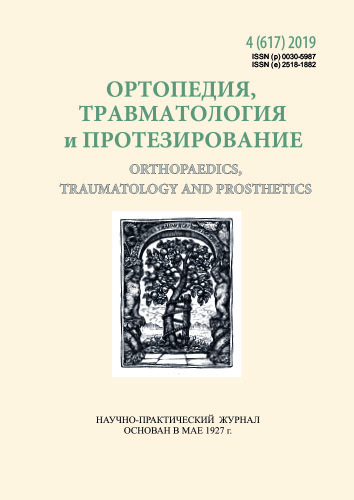Type of anesthesia for lumbar spine surgery in prone position
DOI:
https://doi.org/10.15674/0030-59872019437-41Keywords:
spine surgery, anesthesia, hemodynamics, blood loss, intraocular pressureAbstract
Lumbar spine surgery may be performed under general or spinal anesthesia. There are no criteria for choosing of anesthesia type for such surgery. Objective: to justify the tepe of anesthesia for lumbar spine surgery in prone position. Methods: 254 patients with degenerative lumbar spine diseases ASA I–II were prospectively enrolled to the study. Patients of the spinal anesthesia group (n = 144) were operated under spinal anesthesia, patients of the TIVA group were operated under total intravenous anesthesia. We evaluated the hemodynamics, blood loss, intraocular pressure (IOP) in supine position before and immediately after surgery. Control group was formed by healthy volunteers in whom intraocular pressure was measured before and immediately after lying in the prone position during 90 minutes. Results: turning of non-anesthetized patients into prone position led to decreasing of stoke volume by 25.5 %. We compared these data with intraoperative requirements for sympathomimetics and we could work out the prognostic index of hemodynamic instability (PIHI). In patients with PIHI ≥ 0.5 the risk of intraoperative hemodynamic instability under spinal anesthesia was high. Blood loss in patients with controlled hypotension (mean blood pressure 60–80 mm Hg) did not differ between the groups. Surgery time was significantly higher in TIVA group. Intraocular pressure in prone position was higher, than in supine position. The most significantly IOP increased in TIVA patients on the turned head side. IOP in SA patients did not differ from healthy volunteers. Conclusions: before surgery in prone position it is helpful to evaluate hemodynamic reactions for the body position changes. In cases of PIHI ≥ 0.5 it is better to choose general anesthesia. Type of anesthesia does not influence on the blood loss if controlled hypotension is used. IOP increases significantly in prone position under TIVA.References
- Martin, B. I., Mirza, S. K., Spina, N., Spiker, W. R., Lawrence, B., & Brodke, D. S. (2019). Trends in Lumbar Fusion Procedure Rates and Associated Hospital Costs for Degenerative Spinal Diseases in the United States, 2004 to 2015. SPINE, 44 (5), 369–376. doi: 10.1097/brs.0000000000002822
- Attari, M., Mirhosseini, S., & A. Honarmand, M. (2011). Safavic Spinal anesthesia versus general anesthesia for elective lumbar spine surgery: A randomized clinical trial. Journal of research in medical sciences : the official journal of Isfahan University of Medical Sciences, 16 (4), 524–529.
- Finsterwald, M., Muster, M., Farshad, M., Saporito, A., Brada, M., & Aguirre, J. A. (2018). Spinal versus general anesthesia for lumbar spine surgery in high risk patients: Perioperative hemodynamic stability, complications and costs. Journal of Clinical Anesthesia, 46, 3–7. doi: 10.1016/j.jclinane.2018.01.004
- Hollman, F., Wolterbeek, N., & Veen, R. (2015). Risk Factors for Postoperative Urinary Retention in Men Undergoing Total Hip Arthroplasty. Orthopedics, 38 (6), e507–e511. doi: 10.3928/01477447-20150603-59
- Kamel, I. (2014). Positioning patients for spine surgery: Avoiding uncommon position-related complications. World Journal of Orthopedics, 5 (4), 425. doi: 10.5312/wjo.v5.i4.425
- Lizogub, M. V., Georgiants, M. A., Vysotska, O. V., Porvan, A. P., & Lizogub, K. I. (2009). A method for predicting adverse changes in hemodynamics on the background of spinal anesthesia. Patent 131991 UA.
- Zorrilla-Vaca, A., Healy, R. J., & Mirski, M. A. (2017). A Comparison of Regional Versus General Anesthesia for Lumbar Spine Surgery. Journal of Neurosurgical Anesthesiology, 29 (4), 415–425. doi: 10.1097/ana.0000000000000362
- Meng, T., Zhong, Z., & Meng, L. (2016). Impact of spinal anaesthesia vs. general anaesthesia on peri-operative outcome in lumbar spine surgery: a systematic review and meta-analysis of randomised, controlled trials. Anaesthesia, 72 (3), 391–401. doi: 10.1111/anae.13702
- Pınar, H. U., Kaşdoğan, Z. E., Başaran, B., Çöven, İ., Karaca, Ö., & Doğan, R. (2018). The effect of spinal versus general anesthesia on intraocular pressure in lumbar disc surgery in the prone position: A randomized, controlled clinical trial. Journal of Clinical Anesthesia, 46, 54–58. doi: 10.1016/j.jclinane.2018.01.026
Downloads
How to Cite
Issue
Section
License
Copyright (c) 2020 Mykola Lyzohub, Igor Kotulskiy, Kseniia Lyzohub, Natalya Moskalenko, Victoriia Pishchik

This work is licensed under a Creative Commons Attribution 4.0 International License.
The authors retain the right of authorship of their manuscript and pass the journal the right of the first publication of this article, which automatically become available from the date of publication under the terms of Creative Commons Attribution License, which allows others to freely distribute the published manuscript with mandatory linking to authors of the original research and the first publication of this one in this journal.
Authors have the right to enter into a separate supplemental agreement on the additional non-exclusive distribution of manuscript in the form in which it was published by the journal (i.e. to put work in electronic storage of an institution or publish as a part of the book) while maintaining the reference to the first publication of the manuscript in this journal.
The editorial policy of the journal allows authors and encourages manuscript accommodation online (i.e. in storage of an institution or on the personal websites) as before submission of the manuscript to the editorial office, and during its editorial processing because it contributes to productive scientific discussion and positively affects the efficiency and dynamics of the published manuscript citation (see The Effect of Open Access).














